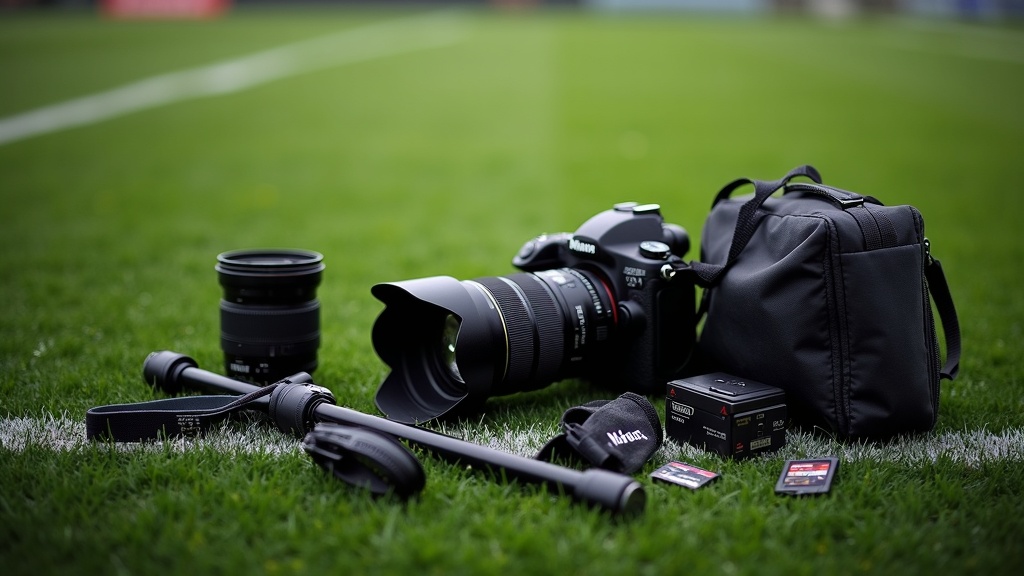Soccer photography can be fast paced, full of action, and just a bit unpredictable. Especially on match day, nailing your shots takes more than just a good camera—it’s about knowing the sport, your equipment, and anticipating those fleeting moments that define a game. Over the years, I’ve realized that standing out in soccer photography is as much about preparation and timing as it is about the gear in your bag or the settings on your camera.

Basic Equipment for Soccer Match Photography
Soccer photography gets a lot easier and way more fun when you have the right equipment in your gear bag. There are a few basics that’ll really help you capture all the action, and understanding what each type of gear brings to the table can save you time and frustration later.
For starters, a DSLR or mirrorless camera with a fast burst mode works well. You’ll want a camera that handles continuous shooting without missing a beat because the action never stops for you to catch up. Pair it with a zoom lens—something in the 70-200mm or 100-400mm range—which gives you flexibility for both wide shots and closeups, even from behind the sidelines.
I like to throw a few more things into my bag for match day:
- Extra Memory Cards: Soccer matches are full of key moments, and it’s easy to fill a card fast.
- Spare Battery or Two: Burst mode drains batteries pretty quickly.
- Monopod: Long lenses can get heavy; using a monopod gives your arms a break without slowing you down.
- Weather Protection for Gear: Matches go on even if it rains. A cheap rain cover is always in my kit, just in case.
If you shoot regularly, it’s worth considering a lens hood to reduce glare and keep your images clear, especially during sunny afternoon games. And don’t forget comfortable shoes—standing and moving for an entire match can take a toll on your feet. The right footwear keeps you quick on your toes, ready to chase the action wherever it goes.
Understanding Soccer Match Day Dynamics
Every soccer match has its unique rhythm and flow. Getting to know the rules, the most common moments to look for, and even how players react under pressure helps you anticipate what’s coming next. This understanding gives you the edge needed to predict and capture intense tackles, goal celebrations, and dramatic saves as they unfold.
It’s not just about having the camera ready, it’s about keeping your mind in the game. I’ve learned that watching the offball action—the coach on the sideline calling plays or a defender anticipating a run—can lead to some of my favorite shots. For those just starting out, it helps to watch games on TV or in person, focusing on how momentum changes quickly so you’re prepared to move and react, too. The energy of the crowd can also lead to moments worth photographing, especially during big plays or penalties.
Getting Ready: Preparing for Match Day
Preparation begins before the opening whistle. I make sure to:
- Scout the Venue: Arriving early gives you time to check out the best shooting spots, the light, and possible obstacles such as security fencing or advertising boards.
- Set Up Camera Settings: I usually start with a shutter speed of 1/1000th of a second or higher to freeze action. ISO goes up or down depending on the light. Aperture is often wide open (f/2.8 to f/4) to blur out distracting backgrounds.
- Review the Match Lineups: This helps you know which players to watch. For local tournaments or youth matches, getting to know the standout players ahead of time pays off.
Checking the weather forecast is helpful as well, since bright sunlight and overcast conditions need different approaches for exposure and white balance. If you know rain is on the way, planning where you’ll keep dry or keep gear covered makes a big difference.
Soccer Photography Techniques for Game Day
Soccer matches won’t slow down for the camera, so a few tried and true techniques make a big difference:
- Continuous Autofocus: Set your camera to AI Servo (Canon) or AF-C (Nikon/Sony) to track moving players smoothly.
- Burst Mode: Hold down the shutter and let your camera fire off a series of shots. This almost guarantees at least one sharp, perfectly timed photo in each burst.
- Shoot from Low Angles: Crouching down near the ground can make players look powerful and adds some drama to your shots.
I typically stay near the sidelines, somewhere between midfield and the penalty box. This area offers a good view of most plays, especially attacking drives and defensive scrambles. Depending on the venue and the event, there might be rules about where you can stand; always check with staff beforehand so you’re in the right place when the whistle blows.
Catching the Action as It Happens
Peak action doesn’t always come when you expect it. Sometimes, the best shots arrive just after the play—like when a player celebrates a goal or reacts to a near miss. Keeping your camera up and finger on the shutter, even after the ball leaves the action, captures genuine reactions and emotion that make your photos come alive.
Try to anticipate where the ball will go. Most goals stem from crosses, rebounds, or clever passes rather than straightforward runs. I often prefocus on clusters of players inside the box or just outside the penalty area, then shoot bursts as the play develops. Don’t be afraid to move up and down the line if you can, repositioning to catch fresh angles or focus on a specific player’s story.
Common Challenges and How to Handle Them
Even with great preparation, soccer photography will always throw a few curveballs your way. Here are some common challenges and how I work around them:
- Bad Lighting: Stadium floodlights or heavy clouds can mess with your exposure. Shooting in RAW gives you more flexibility to bring back detail and fix color in post.
- Blurred Motion: If your shots aren’t sharp, crank up your shutter speed and allow ISO to rise. Sharp images maintain the excitement of the action without looking messy.
- Busy Backgrounds: Using a wide aperture (low f-number) blurs the background and makes players stand out. Positioning yourself so clutter is minimized in the frame—such as shooting toward the stands or open field—also does the trick.
- Muddy or Wet Fields: Rain is part of the adventure. Bring a towel or lens cloth to keep your gear dry, and throw a rain sleeve in your bag. Mud splashes or water drops can actually add energy to your images, making those gritty moments pop.
Sometimes, press or security rules will keep you out of a prime spot. If that happens, adapt quickly. Ask staff or organizers about where you can shoot, and respect any boundaries so you don’t miss out on future opportunities.
Advanced Soccer Photography Tips
Feeling confident with the fundamentals? Here are some ways to really step up your soccer images:
Experiment with Panning: Following a moving player with your camera at a slower shutter speed (try 1/200 to 1/400 sec) creates a streaked background while keeping the athlete sharp. This effect, when done right, gives a sense of speed and energy to the shot.
Track Down Story Moments: Not all magic happens on the ball. Look for images that tell the story—coaches immersed in thought, quiet moments during a water break, dramatic crowd reactions. These side moments can give your collection a unique edge.
Edit Selectively: Don’t get overwhelmed by hundreds of images. As soon as I finish a match, I quickly pick out my highlights. Simple edits—like bumping contrast, adjusting brightness, and cropping to spotlight key action—can give ordinary shots a fresh look.
Work on Timing: Instead of just holding down the shutter, practice timing your shots to anticipate passes, tackles, or celebrations. This saves you time later and gets you in rhythm with the flow of play.
Why Having the Right Equipment Matters
Putting the right gear to work doesn’t mean you have to buy the most expensive items. However, a camera with fast and reliable autofocus plus a quality zoom lens can be a game changer. An older point and shoot usually can’t keep up with fast passing or quick player movement. Upgrading to a camera designed for action sports made it easier for me to spot thrilling moments and grab them without delay.
- Wide Zoom Lenses (24-70mm): Perfect for team huddles, pregame rituals, or halftime snapshots when you’re closer to the players.
- Telephoto Lenses (70-200mm, 100-400mm): Essential for capturing action across the field and making players stand out in busy frames.
- Reliable Backup: Always carry extra memory cards and batteries. You never want to be caught off guard when the deciding goal happens.
Don’t be shy about using secondhand gear if that’s what fits your budget. Reliable equipment is more about speed, accuracy, and durability than bells and whistles. Adjust your setup to match your needs and comfort level; this way, you’ll be able to cover every bit of action confidently and comfortably.
Frequently Asked Soccer Photography Questions
Check out some questions I hear a lot from fellow soccer photography fans:
Question: What’s the best shutter speed for soccer action?
Answer: For most fast plays, start at 1/1000th of a second or quicker. If you want to capture a touch of motion blur—to show the speed of a swinging leg or ball in flight—experiment with 1/800 to 1/500 based on the lighting.
Question: Can I shoot soccer games without a press pass?
Answer: For local tournaments and youth matches, absolutely. Big league events and pro matches usually require a press credential. Always check with organizers before you set up on the sidelines.
Question: Do I need a tripod or monopod?
Answer: A monopod is a lifesaver with heavy lenses, and it lets you move fast. Tripods aren’t common on the sidelines because mobility is key.
Question: How do I keep my camera safe on rainy match days?
Answer: Use a rain sleeve, or go low-tech with a plastic bag in a pinch. Don’t forget a microfiber cloth for regular cleaning during play.
Start Taking Better Soccer Photos Today
Soccer photography on match day is packed with thrills and unpredictable moments. Once you’re familiar with your camera, ideal positions, and the pulse of the game, you’re ready to make pictures that are not just sharp but also full of emotion and narrative. Practice, patience, and these simple tips will make every shoot more rewarding. All you need to do now is grab your camera, get to the field, and stay alert. You never know when that next unforgettable photo will appear!

